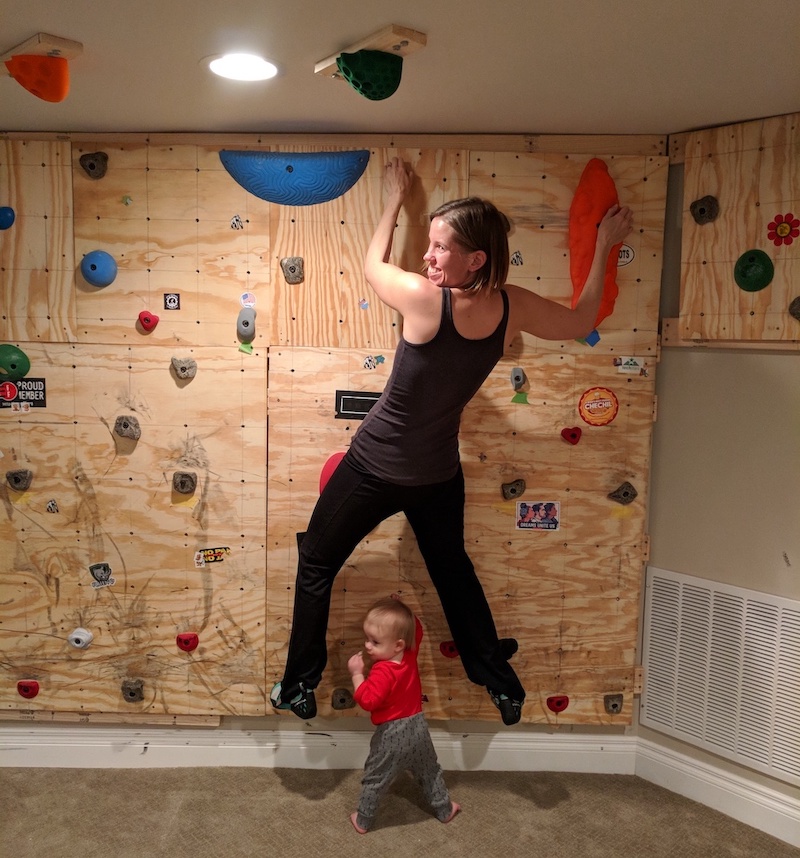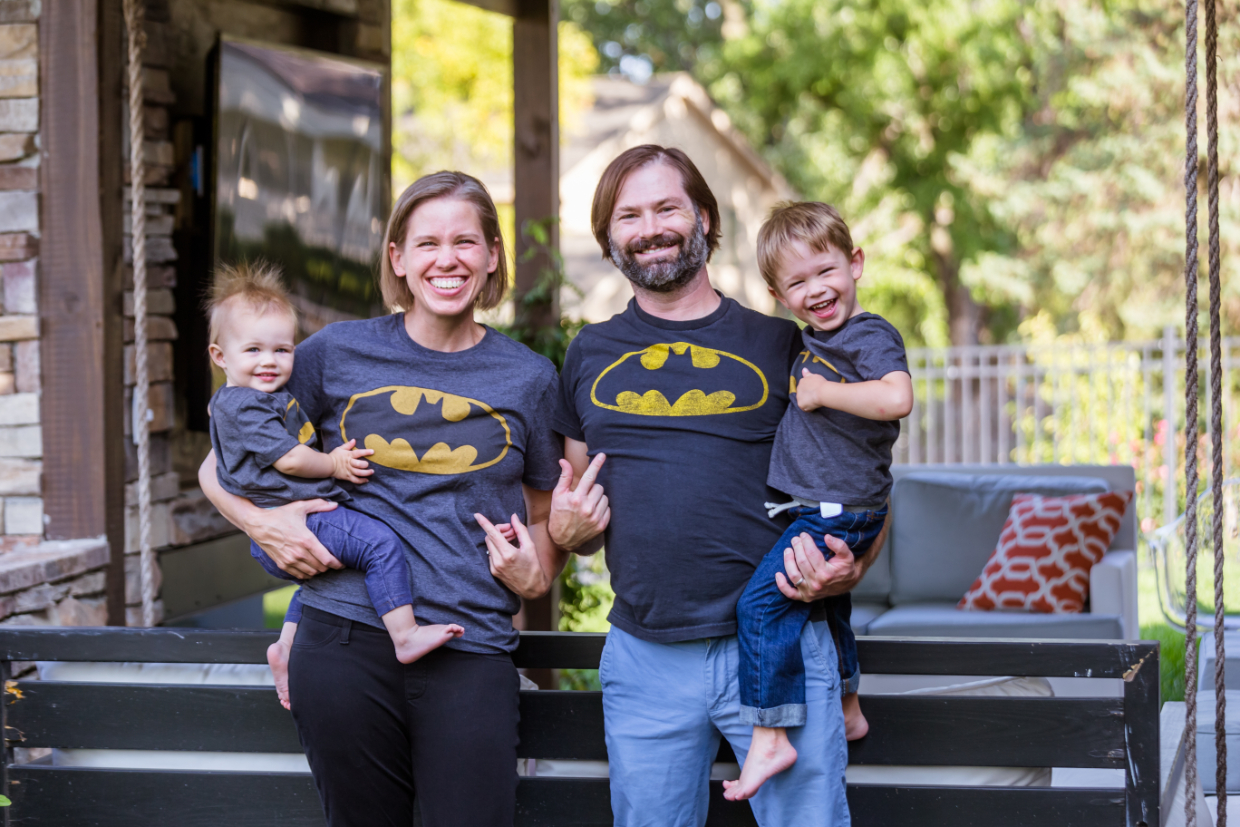What I learned about Software Development from building a Climbing Wall

Theo liked to imitate as he was learning to walk.
TL;DR: This post is just for fun!
I didn’t really learn about programming, this is just a catchy title, and I wanted to share a big project I have continued to work on that has nothing to do with programming. I thought I could make a kind of funny post by stringing together a bunch of programming ‘wisdom’ that could really be associated with nearly anything.

climbing wall’s current state
Prototype, Iterate, Test, and Iterate More
Climbing Wall: If you aren’t sure how much you will use the wall, or how much effort you want to put into it you can start small. Build and expand over time.
Software: In software, most of the time these days folks take an agile / lean approach and try to deliver working MVPs along the life of the project to deliver continuous value and learning.
Prototype
I started really small, initially with a training board. I installed this above the stairs entering the basement.

A training board lets you strengthen your fingers, and do weird pull-ups
Iterate
I then added a few holds directly into the wall near the original board so I could string together a few moves.

A first box of bulk climbing holds, a test mounting on a board
Iterate Again & Again
Then I added a single set of boards on the wall… and started to expand out from there.

empty wall, mounts, one board, and more
Project Planning
Negotiate with the Team
Climbing Wall: I did have to discuss everything with my wife before I started drilling a bunch of holes in our wall. This was a bit of a process, starting with the training board, the wall holes (and an agreement that I would patch any holes… hmm I still have to do some of those. A discussion that became easy as she found she enjoyed adding frequent climbing into her exercise routine as much as I did.
Software: In software you are always working with stakeholders, PMs, designers, other developers, and hopefully directly with some customers. Nearly everything built requires negotiation and compromises on time, features, UX, etc.

negotiation with my partner
It Starts with A Plan
Initially, I started with just a small idea, but it expanded out, especially after my wife decided she also really enjoyed climbing on the wall as well.

planning and materials
Ensure Your Project has a Reasonable Learning Curve
Climbing Wall: On a climbing wall you want it to be fun for beginners, kids, and more experienced climbers. Just like in software you want a project to be accessible and learnable by new hires and developers of different skill levels.
Our wall was a big hit with so many kids, I have added a lot of easier holds and built a lower route so small children can jump on the wall and have a great time.
Software: You can’t build a team, recruit, and mentor folks if you have a software project that is all expert level. Ensure it is easy to set up the apps development environment and it is easy to add features, test, and deploy safely so new folks can learn with confidence.

Theo Climbing, click for video
Set Milestones
On personal projects as in software, you want to set short, medium, & long term goals.
- Short: something at home to help with training for climbing
- Medium: I want to connect all the reasonable basement walls for a long route
- Long: I want to connect the original training board to the route along with ceiling holds
- Longer: I want to add a removable incline that can add a step grade when good climbers are visiting

Adding Ceiling Holds was a longer-term goal
Celebrate Your Wins
Climbing Wall: In general, whenever I expanded the climbing wall, I would quickly add some holds and celebrate by climbing my new longer route.
Software: Your team should be proud and get to celebrate after shipping something big. Also, ensure developers are sharing the things they learned along the release with the team. Having space to make investments and to pay down debt, requires that everything can’t always be moving at maximum speed all the time. Celebrate the progress folks are making.

Climbing the Routes as the wall is in progress

Erin testing our new “door crossing” problem
Plan For Growth
Climbing Wall: On the wall, I would build and leave space to add more when I had the time.
Software: In software, you want code that is flexible and easy to adapt. This doesn’t mean to over optimize, but know when to be specific and when to offer flexibility (the rule or threes can help with this).

Gaps When, low on Supplies
Make it work, make it right, make it fast
Climbing Wall: The wall was built to keep up and extend my skill level… When I didn’t have the parts or the time, I would sometimes make something fast and leave gaps to extend the routes.
Software: In software, make sure you can get it working, this ensures you solve the hard problems. Then make it right soft the edge cases and the gotchas. Then make it fast and scalable.

color coded climbing routes
Learning & Growth
Climbing Wall: As I worked on the wall project I became better with tools, building, designing routes, & more. I got comfortable and started to think up some more complex projects.
Software: Software takes practice, you will get better the more you build things. Learning which practices to follow and which don’t scale well.
You Can Learn Anything
Climbing Wall: I seriously know very little about building things, tools, construction, or really even climbing. All the information you need is available online to learn so much about any topic that interests you.
Software: You are always learning in software. A new framework, language, domain, etc… The field changes so fast that you have to keep learning to stay up to date. To know when something is a fad or is really worth investing time in deep learning.
You Get Better with Practice
Climbing Wall: Originally, I barely knew what size drill bits, bolts, nuts, and holds… Now I can put all this together and set up a new board in almost no time at all.
Software: It is good to keep practicing… Often this is how you learn to navigate all the grey areas of programming. The best solution to a problem isn’t always black and white, often the best practices have edge cases… Learning what to bend and what to break comes with practice and experience. Feeling the pain of maintaining systems over time, knowing what will stick around and what code often just gets removed.

over time, building became faster
It Takes A Team
Climbing Wall: You can’t hold up 4x4 plywood and drill it in yourself… Building a climbing wall requires teamwork. Collaboration to successfully complete the project.
Software: In software, most projects can’t be done by a single developer anymore. It takes collaboration, coordination, and teamwork to build something that lasts.

A few of the friends who have helped out
Learn From Prior Art
Climbing Wall: I read a number of things to learn how to build a climbing wall, this free build a climbing wall e-book from Atomik is great. No reason to try to learn from scratch.
Software: Not often are you building a program from scratch with no prior art. Learn from existing frameworks, applications, books, and open source. Build on the shoulders of giants as they say.

Start Cheap and Upgrade Later
Climbing Wall: I started with some cheap holds, but over time I upgraded to nicer holds over time as I spent more time on the wall and as I expanded it. In the end, I really love atomik climbing holds, and I buy most of my equiptment there.
Software: In a software startup or a feature, you want to find the fastest and cheapest way to verify the value of something. When you know there is a value and have been able to build something sustianable (or I guess in startup world, with a hockey stick growth), you might want to move on from “it works” to it is best in class… Particularly, for things that aren’t part of the core company business value.

Cheap bulk grey holds, later upgraded to various specialty holds
